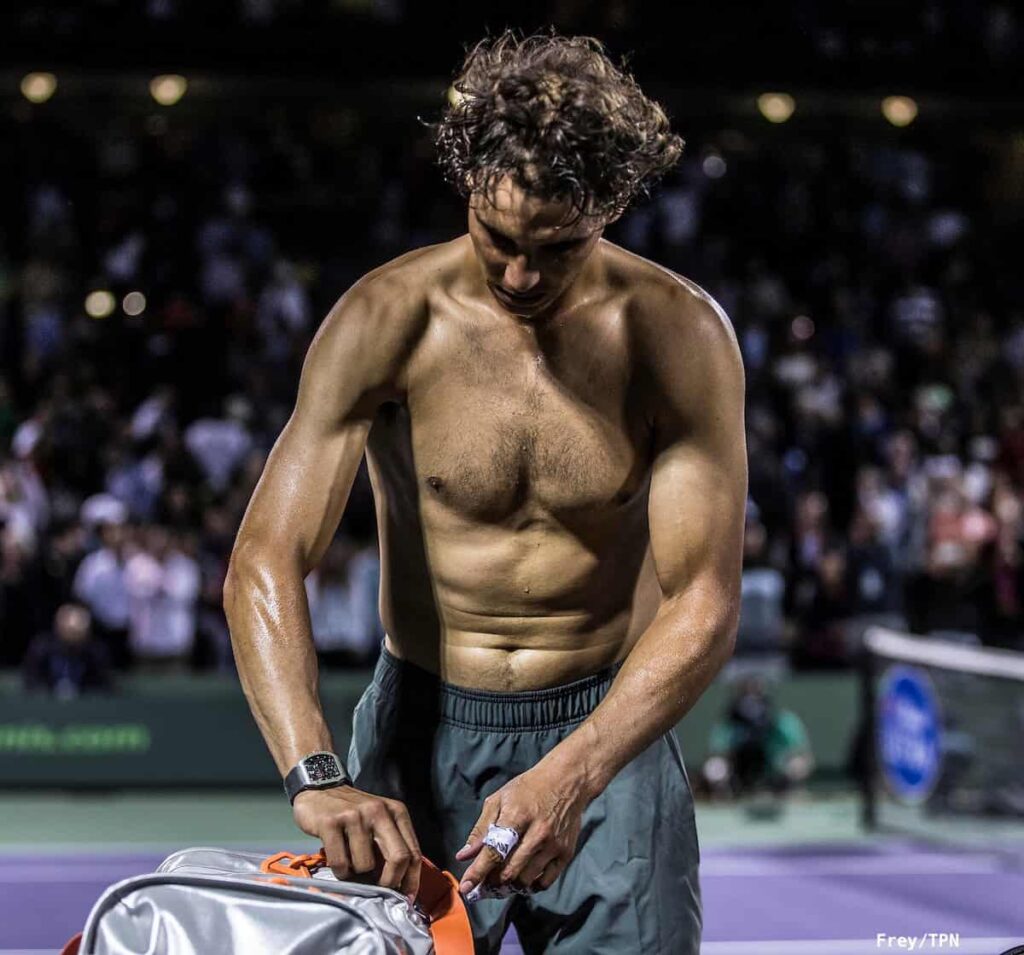Getting to break point against Rafael Nadal is one thing. Good luck converting it. It will feel as though you are playing an entirely different sport.
Nadal defeated John Isner 7-6 (8), 7-6 (3) in the 2013 Cincinnati Masters 1000 final by saving all three break points he faced. It was the first time in his career that the Spaniard had won back-to-back hard court titles (Canada & Cincinnati).
Nadal Serving 5-6, 15-40
Crunch time in this match came late in the first set as Nadal faced two break points at 5-6, 15-40 – which also carried the added weight of being two set points for Isner.
At 15-40, Nadal hit a 110 mph hard slice down the middle that Isner floated wide down the line. This was the primary 1st serve pattern for Nadal in the Deuce court.
Nadal Deuce Ct T Serves (to Isner’s backhand)
- 22 Attempted
- 17 made (77%)
- 13 won (76%)
The effectiveness of this serve was complemented by Nadal’s secondary pattern out wide in the deuce court to Isner’s forehand.
Nadal Deuce Ct Wide Serves (to Isner’s forehand)
- 11 attempted
- 7 made (64%)
- 7 won (100%)
IMPROVE YOUR MENTAL GAME
Course: Getting Tight
Webinar 70: Closing Out A Set
Webinar 65: Reducing Risk
Webinar 53: Pre-Match Nerves
Webinar 36: Make Better Decisions
Nadal faced his second break point on the next point at 30-40. The whole world (including Isner) thought Nadal would use his favorite lefty slider out wide to Isner’s backhand in the Ad court. Instead, Nadal sent a 113mph ace right down the middle to Isner’s forehand.
Gotcha.
Isner, anticipating the serve going to his backhand, didn’t move as his second set point went speeding right by him. In the Ad court, Nadal mixed his first serve location a lot more than normal, attempting 18 first serves down the middle and winning 10 compared to only 12 out wide to his favorite lefty location, where he won eight.
One of Nadal’s many strengths is to put his opponent first and get inside his head to figure out what they are anticipating and then go the other way.
This was clearly evident on the next point at deuce as Nadal served another pressure-packed ace. This time it was a gutsy second serve out wide to Isner’s forehand, who was headed the other way, anticipating it going to his backhand. Isner had been trying to run around second serves all match to upgrade from a backhand to a forehand return, so this was the perfect time to go wide when he had left early to cover the middle.
Isner then missed a backhand return long off a first serve on the next point to send the set to a tie-breaker.
From 15-40, Isner didn’t get a ball back in the court as Nadal took his game, both physically and mentally, to another level.
To understand Rafa’s greatness, read that last sentence again.
Nadal again used the surprise second serve wide to the forehand in the deuce court at 5-5 in the first set tie-breaker as Isner barely got a racquet on it and sliced a forehand return long. It was yet another pivotal point where Rafa successfully anticipated Isner’s movements and strategy.
Isner held his third set point with Nadal serving at 6-7 in the tie-break. Nadal again surprised with a first serve to the forehand, which Isner sliced back to Nadal’s forehand. Isner committed a backhand error from deep in the court on the very next shot. Nadal won the first set with a wicked forehand jam second serve at 9-8 that Isner could not get back over the net.
Nadal Saves Third Break Point
Nadal saved his third break point of the match at 3-3, 30-40 in the second set when he again jammed Isner’s forehand return with a second serve. The Spaniard ended up at the net, hitting a deft backhand volley winner two shots later.
Nadal was only broken four times from 18 opportunities (22%) for the entire tournament, while he was able to break 13 times from 35 attempts (37%). Nadal’s outstanding year so far, in which he has now won nine titles, is built on his toughness in break-point situations, where he is third best on tour in both break points converted and saved.
Serve +1 Forehands
A key tactic for both players in the match was hitting a forehand as the first shot after the serve, effectively combining the strength of the forehand and serve into one unit to begin the point.
Nadal Serve +1
- Serve +1 Forehands = 45 (87%)
- Serve +1 Backhands = 7 (13%)
Isner Serve +1
- Serve +1 Forehands = 48 (94%)
- Serve +1 Backhands = 3 (6%)
Once the point got past the first two shots, it was the forehand from both players that dominated the back of the court as well. The only backhand winner for the match came on the very first point with Nadal hitting a passing shot down the line. From there on, both players would combine for 33 forehand winners (Isner 21/Nadal 12).
Isner also tried coming to the net when possible, but could only win 52% (10/19) of his net points. Nadal was much more successful, winning 71% (10/14) of his points finishing at the front of the court.
Nadal’s successful French Open campaigns, which he has won eight times, are built around winning lead-up Masters 1000 events in Monte Carlo, Rome, and Madrid. His clay court confidence especially comes from saving break points at those events, so he arrives in Paris feeling like Superman.
Nadal has now won successive Masters titles in Montreal and Cincinnati, and opponents have only managed to convert exactly 4/18 in both events = 8/36 total (22%). There is a certain sense of déjà vu in Nadal’s preparation as he heads to New York searching for his 13th career Grand Slam title.


